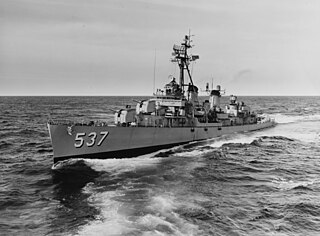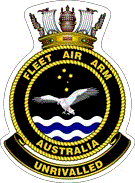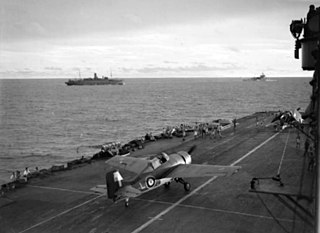
A plane guard is a warship (commonly a destroyer or frigate) or helicopter tasked to recover the aircrew of planes or helicopters which ditch or crash in the water during aircraft carrier flight operations.

A plane guard is a warship (commonly a destroyer or frigate) or helicopter tasked to recover the aircrew of planes or helicopters which ditch or crash in the water during aircraft carrier flight operations.
For ships, the plane guard is positioned at 500 to 2000 yards behind the carrier and either directly behind the carrier, or at a point 15 degrees off to starboard, intersecting the final approach line to angled deck carriers. The plane guard ship's position provides an additional point of reference to approaching aircraft. One of the ship's boats is prepared for launch and swung over the side, but not placed in the water. If an aircraft ditches or crashes, either while approaching the carrier to land or following a failed landing, the ship proceeds to the approximate position of the aircraft, and the prepared boat is deployed to rescue the aircrew.[ citation needed ]
The plane guard role is dangerous for ships, as aircraft carriers must often change speed and direction to preserve optimum take-off and landing conditions for their aircraft, and a lack of awareness or any incorrect manoeuvres on the part of either ship can place a plane guard ship under the bows of a carrier travelling at full speed. The USS Hobson was lost while incorrectly manoeuvering during plane guard duties which resulted in a collision with the aircraft carrier USS Wasp (in 1952). [1] Both HMAS Voyager (in 1964) and USS Frank E. Evans (in 1969) were lost under similar circumstances in collisions with the Australian aircraft carrier HMAS Melbourne. [2]


After World War II, plane guard duties and search-and-rescue roles were sometimes carried out by amphibious aircraft. However, prior to the Korean War helicopters were discovered to be more efficient and effective in both roles. [3] As helicopters came into more common usage, they supplemented and sometimes replaced plane guard ships, as they could retrieve crashed aircrew faster and more safely than ships. [4] However, night operations still required a ship in the plane guard position. [4]
This is a list of aviation-related events from 1982.

The Battle of the Philippine Sea was a major naval battle of World War II on 19–20 June 1944 that eliminated the Imperial Japanese Navy's ability to conduct large-scale carrier actions. It took place during the United States' amphibious invasion of the Mariana Islands during the Pacific War. The battle was the last of five major "carrier-versus-carrier" engagements between American and Japanese naval forces, and pitted elements of the United States Navy's Fifth Fleet against ships and aircraft of the Imperial Japanese Navy's Mobile Fleet and nearby island garrisons. This was the largest carrier-to-carrier battle in history, involving 24 aircraft carriers, deploying roughly 1,350 carrier-based aircraft.

A light aircraft carrier, or light fleet carrier, is an aircraft carrier smaller than the standard carriers of a navy. The precise definition of the type varies by country; light carriers typically have a complement of aircraft only one-half to two-thirds the size of a full-sized fleet carrier. A light carrier was similar in concept to an escort carrier in most respects, however light carriers were intended for higher speeds to be deployed alongside fleet carriers, while escort carriers usually defended equally slow convoys and provided air support during amphibious operations.

HMS Theseus/ˈtʰeː.seu̯s/, [ˈt̪ʰeːs̠ɛu̯s̠](R64) was a Colossus-class light fleet aircraft carrier of the Royal Navy. Theseus was laid down on 6 January 1943 by Fairfield at Govan, and was launched on 6 July 1944. She was involved in the Korean War and the Suez Crisis. The scrapping of the Theseus was commenced on 29 May 1962 at Inverkeithing, Scotland.

The flight deck of an aircraft carrier is the surface from which its aircraft take off and land, essentially a miniature airfield at sea. On smaller naval ships which do not have aviation as a primary mission, the landing area for helicopters and other VTOL aircraft is also referred to as the flight deck. The official U.S. Navy term for these vessels is "air-capable ships".

HMAS Melbourne (R21) was a Majestic-class light aircraft carrier operated by the Royal Australian Navy (RAN) from 1955 until 1982, and was the third and final conventional aircraft carrier to serve in the RAN. Melbourne was the only Commonwealth naval vessel to sink two friendly warships in peacetime collisions.

The Battle of the Santa Cruz Islands, fought during 25–27 October 1942, sometimes referred to as the Battle of Santa Cruz or Third Battle of Solomon Sea, in Japan as the Battle of the South Pacific, was the fourth aircraft carrier battle of the Pacific campaign of World War II. It was also the fourth major naval engagement fought between the United States Navy and the Imperial Japanese Navy during the lengthy and strategically important Guadalcanal campaign. As in the battles of the Coral Sea, Midway, and the Eastern Solomons, the ships of the two adversaries were rarely in sight or gun range of each other. Instead, almost all attacks by both sides were mounted by carrier- or land-based aircraft.
This is a list of aviation-related events from 1991.

USS The Sullivans (DD-537) is a retired United States Navy Fletcher-class destroyer. The ship was named in honor of the five Sullivan brothers aged 20 to 27 who died when the light cruiser, USS Juneau, was sunk by a Japanese submarine during the Naval Battle of Guadalcanal on 13 November 1942. This was the greatest military loss by any one American family during World War II. She was also the first ship commissioned in the Navy that honored more than one person.

HMAS Sydney (R17/A214/P214/L134) was a Majestic-class light aircraft carrier operated by the Royal Australian Navy (RAN). She was built for the Royal Navy and was launched as HMS Terrible (93) in 1944, but was not completed before the end of World War II. The carrier was sold to Australia in 1947, completed, and commissioned into the RAN as Sydney in 1948.

USS Williamson (DD-244/AVP-15/AVD-2/APD-27) was a Clemson-class destroyer in the United States Navy during World War II. She was named for Commander William Price Williamson.

USS Patterson (DD-392), a Bagley-class destroyer, was the second ship of the United States Navy to be named for Daniel Todd Patterson, an officer of the US Navy who served in the Quasi-War with France, First Barbary War, and the War of 1812.

The Fleet Air Arm (FAA), known formerly as the Australian Navy Aviation Group, is the division of the Royal Australian Navy (RAN) responsible for the operation of aircraft. The FAA was founded in 1947 following the purchase of two aircraft carriers from the Royal Navy. FAA personnel fought in the Korean War and the Vietnam War, and participated in later conflicts and operations from host warships.

USS Wiltsie (DD-716) was a Gearing-class destroyer in the United States Navy. She was named for Irving Wiltsie. The destroyer entered service in 1946 and remained active with the United States Navy until 1977, when Wiltsie was decommissioned and sold to Pakistan in 1977. The vessel entered service with the Pakistan Navy as PNS Tariq (D165) in 1978. In 1990, the ship was renamed PNS Nazim to allow the name Tariq to be given to a newly-acquired Type 21 frigate. The ship was then transferred to the Pakistan Maritime Security Agency and used as an alongside "at sea" headquarters for the agency. Though afloat, the vessel no longer sails.

USS Bering Strait (AVP-34) was a United States Navy Barnegat-class small seaplane tender in commission from 1944 to 1946. She tended seaplanes during World War II in the Pacific in combat areas and earned three battle stars by war's end.
The Melbourne–Voyager collision, also known as the Melbourne–Voyager incident or simply the Voyager incident, was a collision between two warships of the Royal Australian Navy (RAN); the aircraft carrier HMAS Melbourne and the destroyer HMAS Voyager.

The Melbourne–Evans collision was a collision between the light aircraft carrier HMAS Melbourne of the Royal Australian Navy (RAN) and the destroyer USS Frank E. Evans of the United States Navy (USN). On 3 June 1969, the two ships were participating in SEATO exercise Sea Spirit in the South China Sea. Around 3:00 am, when ordered to a new escort station, Evans sailed under Melbourne's bow, where she was cut in two. Seventy-four of Evans's crew were killed.

725 Squadron is a naval aviation squadron of the Royal Australian Navy (RAN) Fleet Air Arm. The squadron was originally created in August 1943 as part of the Fleet Air Arm of the Royal Navy. It initially served as a fleet requirements unit, was rerolled in August 1945 as a target towing unit, then was disbanded in December 1945. In January 1958, the squadron was re-formed, as a fleet requirements and communications unit of the RAN, operating a variety of fixed-wing aircraft. The squadron was redesignated as an anti-submarine warfare training squadron in May 1959, then was decommissioned in May 1961 and absorbed into 724 Squadron. 725 Squadron was recommissioned in November 1962 as an operational anti-submarine helicopter squadron, flying the Westland Wessex. During this commission, the squadron was involved in HMAS Sydney's troop transport voyages, the rescue of personnel following the Melbourne-Voyager collision, and the Operation Navy Help Darwin relief effort post-Cyclone Tracy. The squadron was decommissioned in December 1975. 725 Squadron was commissioned for the fourth time in June 2015, this time as a training unit for MH-60R Seahawk Romeo helicopters: the squadron had been reactivated two years prior as a non-commissioned unit train on and accept into service the Romeos.

Aircraft carriers are warships that evolved from balloon-carrying wooden vessels into nuclear-powered vessels carrying many dozens of fixed- and rotary-wing aircraft. Since their introduction they have allowed naval forces to project air power great distances without having to depend on local bases for staging aircraft operations.

The Essex class was a class of aircraft carriers of the United States Navy. The 20th century's most numerous class of capital ship, the class consisted of 24 vessels, which came in "short-hull" and "long-hull" versions. Thirty-two ships were ordered, but as World War II wound down, six were canceled before construction, and two were canceled after construction had begun. Fourteen saw combat during World War II. None were lost to enemy action, though several sustained crippling damage. Essex-class carriers were the backbone of the U.S. Navy from mid-1943 and, with the three Midway-class carriers added just after the war, continued to be the heart of U.S. naval strength until supercarriers joined the fleet in the 1950s, 1960s and 1970s. Several of the carriers were rebuilt to handle heavier and faster aircraft of the early jet age, and some served until well after the Vietnam War.